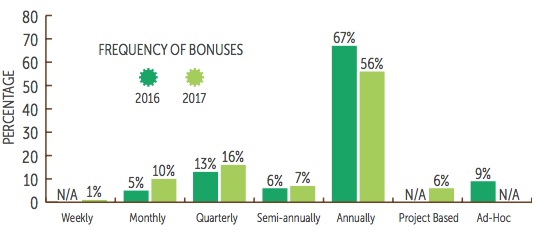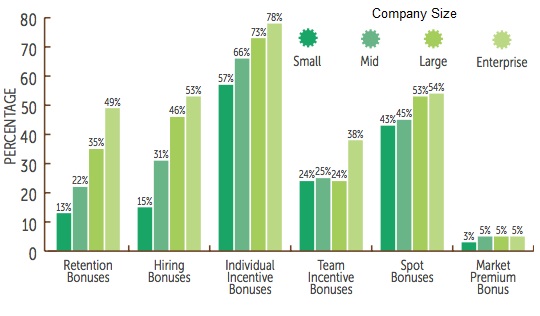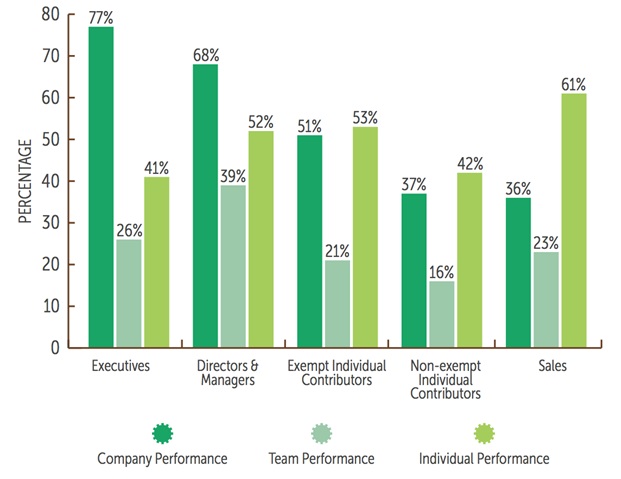A rich compensation mix encompasses much more than base pay alone, there are bonuses, incentives, benefits and much more to consider. Together, all these pay elements create a total rewards package for employees.
However, variable pay can also be a powerful manifestation of company culture. For example, why not offer spot bonuses for individuals who show strong examples of the company’s core values? If an organization prioritizes collaboration, why not give a bonus to the individual who stayed late helping a coworker finish a project? If risk-taking is a core tenet, an employer could turn heads by rewarding a failed project, simply because an individual was bold enough to try something new.
Variable pay includes a number of different programs including individual incentive bonus, team bonus, year-end bonus, hiring bonus commissions, retention bonus and project bonus. PayScale’s 2017 Compensation Best Practices Report examined the practice of paying bonuses and found the prevalence has increased over time. This year’s data shows variable pay continues to be a prominent component in the modern compensation landscape. Approximately 74% of all organizations surveyed said they offer some type of variable pay to employees. That number is even higher among top-performing companies — who are more likely to incorporate variable pay in their compensation strategies (82% versus 73% of typical companies). The research also shows that the larger the company, the more likely it is to provide variable pay. In fact, 85% of enterprise companies offer variable pay, versus 69% of small companies.
Frequency of Bonuses Increasing
 Variable pay is not only becoming more common, it’s also becoming more frequent. While it’s still most common to do bonuses or incentives on an annual basis , that number has decreased significantly since the previous year’s survey (67%). Companies are more likely than last year to do bonuses or incentives on a quarterly or monthly basis.
Variable pay is not only becoming more common, it’s also becoming more frequent. While it’s still most common to do bonuses or incentives on an annual basis , that number has decreased significantly since the previous year’s survey (67%). Companies are more likely than last year to do bonuses or incentives on a quarterly or monthly basis.
Organizations use a whole host of variable pay options to reward employees, some of which are more typical than others. While individual incentives remain the most common (64%), a quarter of organizations are using team incentives. Spot or discretionary bonuses remain popular (46%) as well.
Top-performing companies are more likely to give individual incentive bonuses (71% versus 62% of typical companies), team incentive bonuses (32% versus 24% of typical companies) and market premium bonuses (6% versus 4% of typical companies).
 The pervasiveness of bonuses tends to increase with company size. Small organizations are less likely to give a retention (13%) or hiring (15%) bonus, while it is common practice for just about half of enterprise organizations to give retention (49%) or hiring (53%) bonuses.
The pervasiveness of bonuses tends to increase with company size. Small organizations are less likely to give a retention (13%) or hiring (15%) bonus, while it is common practice for just about half of enterprise organizations to give retention (49%) or hiring (53%) bonuses.
While the same percentage of companies gave bonuses as last year (74%), those who did give bonuses were more likely to use a wider variety. Companies are making use of the full variable pay mix, incorporating more retention, hiring and spot bonuses, to name a few.
But who gets variable pay, and why? This year, more organizations report giving executives a bonus or incentive. Sales is much more likely to receive a commission. Non-exempt individual contributors are least likely to receive a bonus, incentive or commission.
Non-exempt Workers Get Bonuses
When organizations begin to develop their variable pay plans, they often assume they’ll be excluding non-exempt employees. But take note, plenty of organizations are giving bonuses (47%) or incentives (18%) to their non-exempt employees. Top-performing companies are more likely to give bonuses at the non-exempt individual contributor level (50% versus 46% of typical companies). In other words, the practice of giving non-exempt employees variable pay is more prevalent than one might think.
What Bonuses Are Based On
We also sought to determine, for each level, what is the basis for allocating variable pay? Or, in other words, what types of goals are linked to variable pay payouts – goals based on company performance, team performance or individual performance? Most commonly, it’s a mix of company performance and individual performance.
More companies report using company performance as part of the executive variable pay mix (77%). Organizations are also more likely to link executive pay to company performance than they are for directors and managers (68%), exempt individual contributors (51%) or non-exempt individual contributors (37%).
Fewer companies report linking non-exempt variable pay with team performance (16%) than individual (42%) or company performance (37%). More organizations connect higher organizational levels with team performance. For example, 39% of directors and managers have a bonus based on team performance.
Variable pay programs are on the rise, as more employers look for ways to reward top performers and also outstanding effort. Ultimately, an employer will want to consider the right types of variable pay for the employees in their organization and the company’s overarching values.
Individuals, especially non-exempt individual contributors, often feel they don’t have an impact on team or organizational goals. Variable pay that is driven by goals is a way to align work with the desired outcomes of the company, while helping individuals feel both empowered and appreciated.

